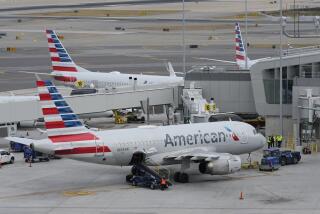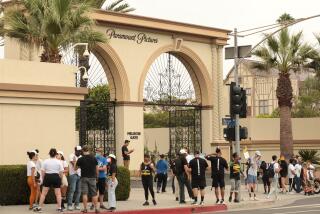The myth of deregulation’s consumer benefits
Here’s a question for you: Is there a single example of consumer prices going down and market competition increasing after deregulation of a U.S. industry?
I’m serious. The phone industry? The cable industry? Regulatory oversight for both was eased — and in some cases eliminated — and look where that’s gotten us.
And now look at the airline industry, which witnessed its latest multibillion-dollar deal Thursday with the merger of American Airlines and US Airways, creating the world’s largest carrier.
Experts were buzzing after the announcement with dire warnings of higher fares, more crowded planes and fewer options for travelers — and they’re probably right.
Once the merger is completed, four airlines — American, United, Delta and Southwest — will control about 75% of the U.S. market.
So I’ll ask again, is there one, just one, example of deregulation working in consumers’ favor?
Richard H.K. Vietor, a professor of business administration at Harvard Business School, said there have been numerous examples of deregulation bringing prices down for varying amounts of time.
In the case of airlines, he said, we’ve enjoyed decades of lower fares since the industry was deregulated in 1978.
“That’s the good thing,” Vietor said. “The bad thing is that, as we’ve seen, competition erodes and you get back to oligopolies.”
The U.S. airline industry now resembles how it looked in the 1930s, he said, with just a handful of carriers controlling most air traffic. As a result, the primary benefit of deregulation — lower fares — could disappear as fewer airlines duke it out for business.
“Consumers used to get meals, free drinks and much better service,” Vietor said. “Now you have to pay for your friggin’ bags.”
Before deregulation, airlines had to ask the Civil Aeronautics Board to sign off on fares and routes. Deregulation allowed carriers to make those decisions for themselves, the hope being that a more market-driven industry would give rise to new competitors and thus push fares lower and improve service.
It’s a song we’ve heard free marketers sing before in defense of all deregulation efforts: Less interference by clumsy old Uncle Sam will unleash the dynamic forces of capitalism and usher in a new era of industrial and consumer paradise (see Rand, Ayn, “Atlas Shrugged”).
AT&T;’s monopoly over phone service ended in 1984 in a government settlement that gave the local phone networks to seven regional operators, known as the Baby Bells. The telecommunications market was deregulated in 1996 in hopes of promoting more competition.
Where are we now? A wave of mergers has resulted in just two companies, AT&T; and Verizon, controlling almost the entire U.S. landline market. AT&T;, Verizon and Sprint account for about 75% of the wireless market.
On the cable side of things, four companies — Comcast, Time Warner Cable, Charter Communications and Cox Communications — now account for about two-thirds of all U.S. subscribers.
Needless to say, phone and cable rates have risen steadily since the telecom market was deregulated.
Airline fares have been a different story. They’ve stayed relatively cheap since deregulation, though many travelers might say service hasn’t exactly been something to cheer about.
Meanwhile, it’s been nothing but turbulence for the airline industry. From 1978 to 2001, nine major carriers and hundreds of smaller ones either went bankrupt or were liquidated. Storied names such as Pan Am, TWA, Eastern and Braniff disappeared.
In recent years, the focus has been on big-ticket consolidation. Delta acquired Northwest. United picked up Continental. And now American and US Airways are tying the knot.
The question is whether all these mergers will finally provide the last carriers standing with more latitude to jack up prices. A decade ago, travelers could choose from 10 major airlines. Now they have fewer than half that number.
“The benefits of deregulation are short- to intermediate-term generally for any industry,” said James Shaw, a professor of business economics at the University of San Francisco.
“A burst of competition and innovation occurs in the short run, and prices fall,” he said. “Consolidation of market players then produces price stability through resultant diminished competition.”
And after that?
“Higher market share, via reduced number of market participants, then promotes higher prices,” Shaw said.
That’s the scenario that’s played out time and time again.
Philip Romero, a professor of finance at the University of Oregon and onetime chief economist for former California Gov. Pete Wilson, said officials shouldn’t be shy about taking the regulatory shackles off businesses.
“Price deregulation is almost always a good idea,” he said, “as long as you have a decent number of market players to ensure competition.”
There’s the rub. Over the long haul, the benefits of deregulation increasingly belong to companies.
“They respond to deregulation by buying each other up and restoring the same lack of competition that existed before deregulation,” Romero said.
“The answer for government,” he said, “is to deregulate but to be much more aggressive on the antitrust side of things.”
In other words, unleash all those wonderful market forces that can come with allowing businesses to run with the ball, but draw the line when, as always seems to happen, businesses run instead into one another’s arms.
Unless your idea of a healthy market is to have just two major phone companies, or two major cable companies, or two major airlines. Or fewer.
David Lazarus’ column runs Tuesdays and Fridays. He also can be seen daily on KTLA-TV Channel 5 and followed on Twitter @Davidlaz. Send your tips or feedback to david.lazarus@latimes.com.







